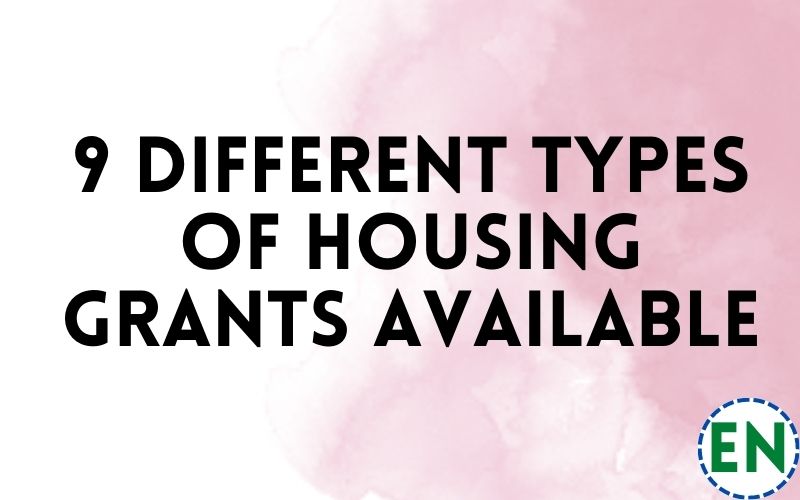9 Different Types Of Housing Grants Available
9 Different Types Of Housing Grants Available

Finding a reasonably priced place to live might be quite difficult if you’re anything like the typical American. In reality, most renter households spend more than 30% of their income on housing expenditures, according to current estimates. And that percentage rises to 70% if you have to deal with the additional hardship of trying to locate a cheap place to live in a high-priced area. Thankfully, assistance is accessible. There are several housing grants available that might turn your goal of owning a home or finding an inexpensive rental into a reality. This blog article will discuss the various housing grants that are offered. Therefore, there is probably a grant out there for you, whether you’re seeking for one to help you buy a home, modify your present home, or pay some other cost of homeownership.
1. Section 8 Housing Grant
The Section 8 housing voucher program is the first category of grant. This grant may be able to cover some of your monthly rent if you have a low income. Your income and the number of people living in your family determine how much aid you will get. You must submit an application and satisfy the program’s eligibility conditions in order to be eligible. This program’s major objective is to assist low-income individuals in finding affordable housing in a secure environment. Additionally, you can be granted preference for this award if you are a senior citizen or a person with a disability. Furthermore, many free housing grants are also available for military veterans.
2. Project-Based Section 8 Housing Grant

Another form of a grant that might assist you in meeting your rent obligations is the Project-Based Section 8 housing program. Property owners that agree to reserve a specific number of units for low-income tenants are eligible for this subsidy. Your salary and the number of people living in your home will determine how much rent you’ll have to pay. You must submit an application and satisfy the program’s eligibility conditions in order to be eligible. The property owner must also consent to take part in the program.
3. Housing Choice Voucher Program
In that it offers low-income renters assistance, the Housing Choice Voucher program is like the Section 8 program. The distinction is that the subsidy is provided to the landlord directly under this arrangement as opposed to the renter. The qualifying standards for this program are identical to those for the Section 8 program and are similarly handled by the local housing authority. If you qualify for this program, you will also be given a voucher that you may use to rent a unit from any landlord that is a member of it.
4. Low Income Housing Tax Credit (LIHTC) Program

Developers and investors that construct or renovate affordable rental housing for low- and moderate-income families are eligible for the federal Low Income Housing Tax Credit (LIHTC) program. By giving investors and developers a financial incentive, the tax credit is meant to promote the development of new, affordable rental housing. State and local housing finance agencies (HFAs) oversee the LIHTC program and distribute the credits to eligible projects in a competitive manner. HFAs analyze projects using a range of techniques, such as scoring systems that take the local housing need, the project’s viability, and the expertise of the developer or investor into account.
5. USDA Rural Development Housing Grant Programs
To help rural homeowners and developers, the U.S. Department of Agriculture (USDA) Rural Development program provides a variety of housing subsidies and loans. For instance, the Section 504 Home Repair Program assists low-income residents in rural regions to repair their houses. In order to assist charitable groups and government organizations in repairing or rehabbing properties that are in danger of being lost due to abandonment or foreclosure, the Housing Preservation Grant program offers financing.
6. VA Home Loan Guarantee Program
One of the oldest and most well-known housing aid programs is the U.S. Department of Veterans Affairs (VA) Home Loan Guarantee Program. It offers low-interest loans to qualified veterans and active-duty service members to assist them to fund the purchase of a property. The program’s main goal is to lower the cost of homeownership for veterans. Furthermore, it is claimed that since its beginning in 1944, this program has assisted more than 22 million veterans and members of the armed forces in purchasing property.
7. Section 502 Direct Loan Program

The U.S. Department of Agriculture’s (USDA) Rural Housing Service administers the Section 502 Direct Loan program, which is intended to assist low- and very-low-income households in financing the purchase or renovation of a home in a rural location. The applicant’s income must not be higher than 115% of the median income in the neighborhood where they seek to buy a house in order to be eligible. Up to 100% of the purchase price or the property’s appraised value, whichever is smaller, may be financed using the loan.
8. HUD Good Neighbor Grants
The HUD Good Neighbor Grants program provides assistance to local governments and nonprofit groups to buy and remodel unoccupied properties in order to sell or rent them at a reduced price to low-income purchasers. By removing abandoned houses and expanding homeownership chances for low-income families, the initiative aims to revive areas. Additionally, the HUD Good Neighbor Grants program provides up to $25,000 per house for rehabilitation costs.
9. Perez Housing Grants
The Department of Housing and Urban Development (HUD) provides the Perez Housing Grants to assist low-income homeowners with making essential repairs and renovations to their houses. The funds can be used to pay for changes in energy efficiency as well as lead abatement, painting, roofing, plumbing, heating, and electrical work. Although there is no maximum amount that may be asked for, most grants are between $1,000 and $4,000. Applicants must fulfill specific income standards and hold a clear title to their house in order to qualify for a Perez Housing Grant. In addition, the applicant’s principal residence must be the property.
Conclusion
In conclusion, the numerous housing grants described above are available to help individuals in need with their housing bills. Whether you’re looking for a grant to assist you with house purchases, home modifications, or other homeownership costs, there is certainly one out there for you. Find out whether you’re eligible for any of these beneficial awards by doing some study.







